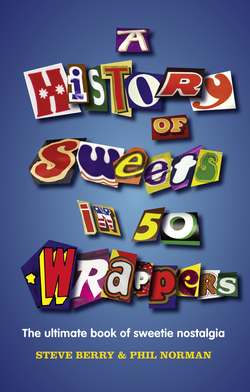Читать книгу A History of Sweets in 50 Wrappers - Steve Berry, Phil Norman - Страница 6
INTRODUCTION
ОглавлениеFor anyone of a certain age, memories of childhood are irrevocably connected to the stomach. The sweet shop was a great leveller. Everyone shopped there, from the Walter Softies to the Bully Beefs (although the bullies would probably steal the softies’ sweets, too). If you were a Milky Bar kid, a Flake girl or one of Fry’s Five Boys, it’s likely that the very first purchase you made with your very own money was something to eat.
There are two acknowledged golden ages of British confectionery. The first came in the 1920s and 1930s when, despite the Depression, the big sweet makers consolidated their brands and expanded nationwide. The second came in the 1970s and 1980s when, despite the Depression, the big names of sweets let their development departments go (fruit and) nuts, shunting out celebrity-endorsed chocolate bars and cartoon-wrapped nougat delights on a weekly basis.
Manufacturing went Technicolor, all the better to catch the wavering eye and stick in the mind for years to come. Sweet shops, until then like antique shops – arthritic, grey and fusty, trapping sunbeams in dust and quietly ossifying – were transformed into glittering Aladdin’s caves, crammed to the rafters with individually wrapped sugared treasures.
Somewhere between decimalisation and globalisation, creative confectionery enjoyed its most fertile period – an auspicious era that began with the last manned moon mission and ended as the first Sky channels beamed into unsuspecting British homes. That journey to the corner shop took on the nature of a pilgrimage for many a child, with a salivating smile and a skipping heartbeat. Inside, a fantastic cornucopia of riches. Some items had a past longer than the shopkeeper himself. Others would go on to outlive him. While many, with hindsight, would never see the year out.
‘Oh, pish, tush and a cheap laugh during a slow edition of QI! It’s Fry’s Five Boys (1902).
None of this mattered to your prospective sweet purchaser, gloriously transfixed as they were in the moment, surveying the ranks of stock. Iconic Mars bars sitting next to the doomed likes of the Cadbury’s Alamo. The Fruit Salad chew, old as the Book of Genesis, shared shelf space with Trebor’s Fings, Rowntree’s Junglies and other sugary mayflies. In the disinterested eyes of the proprietor, all products, as long as someone bought them, were equal. No preferential treatment here. You had to choose wisely, as funds were limited. Governmental sweet rationing may have ended in 1953, but the economic and parental varieties still held sway.
Many products came and went – mere footnotes in their manufacturers’ inventories – but that doesn’t mean they weren’t coveted, adored, consumed with a passion and, just like old friends, noisily revisited a few hours later on the waste ground behind the prefabs. Fortunately a lot of them tasted the same coming up as going down.
Fings ain’t what they used to be (1981), not least for the racist packaging of Trebor’s Black Jacks (1920).
The marketing men inevitably loom large in this tale, coupling childlike imagination with ruthless raiding of money boxes to create a world of hedonistic abandon, populated by models, mascots and maniacal showbiz personalities all merrily hooked on the product – whatever it may be – and keen to let the whole world know. Often in full song.
For better or worse, their efforts made a generation what it is, and what follows is, as much as anything else, an account of how they focus-grouped our Five Centres.
Those big companies can’t help but tinker with their winning brands, all in the name of progress. Recipes are changed, formulas are tweaked, and – most heinously of all – the packaging is modernised. Do not despair. Despite the disappearance of some cherished childhood chocolate bars, many sweets, crisps, snacks and pop are still available if you look hard enough. Only the artificial colours and preservatives have been jettisoned, in favour of ‘all natural’ ingredients.
Don’t believe those people who wax lyrical about the good old days of gobstoppers the size of your head, either. No, those Creme Eggs haven’t got smaller. Your hands have got bigger. In fact, with very few exceptions, the tuck shop fare of youth is served in heftier portions than ever before, as the waddling, wobbling outlines of twenty-first-century obesity crises serve to illustrate.
So here it is, then, your very own unnatural preservative of the best of the Great British sweet shop. Go ahead, dive in – but don’t spoil your tea, now.
Munchies (1957), Mackintosh’s crunchy answer to Rolo. Stablemates Mintola and Delight not pictured.
